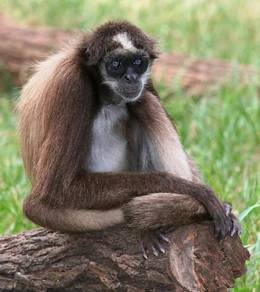
A critically endangered Brown Spider Monkey, Ateles hybridus, with uncommon blue eyes. Shot in captivity in Barquisimeto, Venezuela.
The brown spider monkey, also known as Ateles hybridus lives in sub-tropical rainforests of Venezuela and Colombia. There are two types of Ateles Hybridus: Ateles hybridus brunneus and Ateles hybridus hybridus. Brown spider monkeys are a division of spider monkeys, so there are many similarities between the two. What sets the brown spider monkey apart is their physical appearance. Brown spider monkeys are usually light brown on their back, arms, and legs. They have a white patch starting on their belly going up to their upper chest. The brown spider monkey can also have blue eyes.
Taxonomy[]
The taxonomy of the spider monkeys is based on Kellogg and Goldman (1944) and Hill (1962). The forms hybridus, chamek and marginatus are listed as distinct species and A. fusciceps robustus Allen, 1914 is considered a junior synonym of A. f. rufiventris Sclater, 1871 following Heltne and Kunkel (1975) (see Rylands et al. 2000). Silva-López et al.(1996) argued that Ateles geoffroyi pan was not a valid taxon. Collins (1999) and Collins and Dubach (2000) argued strongly that hybridus I. Geoffroy, 1829 was distinct from belzebuth. Their position was reinforced by Nieves et al. (2005). Hernández-Camacho and Defler (1989) and Defler (2004) argued for the validity of the form brunneus Gray, 1872 from the Departments of Bolivar, Antioquia and Caldas, between the lower Ríos Cauca and Magdalena in Colombia. It is listed here as a subspecies of A. hybridus, as recommended by Defler (2004).
Range and Habitat[]
In Colombia, Ateles hybridus hybridus is found from the right bank of the Río Magdalena in the Departments of Magdalena, César (northward to the southern slopes of the Sierra Nevada de Santa Marta), the south-western portions of Guajira in the northernmost parts of the Serranía de Perijá, and in the middle Río Magdalena valley at least to the Departments of Caldas and Cundinamarca. There are also two populations of this subspecies on the slopes of the Cordillera Oriental of the Andes on the Venezuelan border: one population is found in the Río Catatumbo watershed in the Department of Norte de Santander and the other population is found in the north-east piedmont forest of the Department of Arauca (Hernández-Camacho and Cooper 1976; Defler 2003, 2004).
The subspecies has a disrupted distribution in Venezuela (Mondolfi and Eisenberg 1979). It is located in the north, along the south-eastern part of the Central Mountain Range (Cordillera de la Costa) in the state of Miranda, and probably the state of Vargas. It is also located on both sides of the Venezuelan Andean Mountains (states of Zulia, Táchira, Mérida, Trujillo, Portuguesa, Apure and Barinas). In its eastern part, this primate is distributed on the piedmont forest and in the highly threatened lowland forests of San Camilo and Ticoporo. On the western side, it is also distributed in the piedmont of the Andes throughout the lowland areas of southern Lake Maracaibo to the Perijá Mountains (Sierra de Perijá) along the border with Colombia (Bodini and Pérez-Hernández 1987; Linares 1998; Cordero-Rodríguez and Biord 2001; Portillo and Velásquez 2006; Duque 2007; B. Urbani, unpubl.).
In Colombia, Ateles hybridus brunneus is found between the lower Cauca and Magdalena Rivers in the Department of Bolívar, Antioquia and Caldas. This population has sometimes been included with A. h. hybridus, but is here considered distinct.